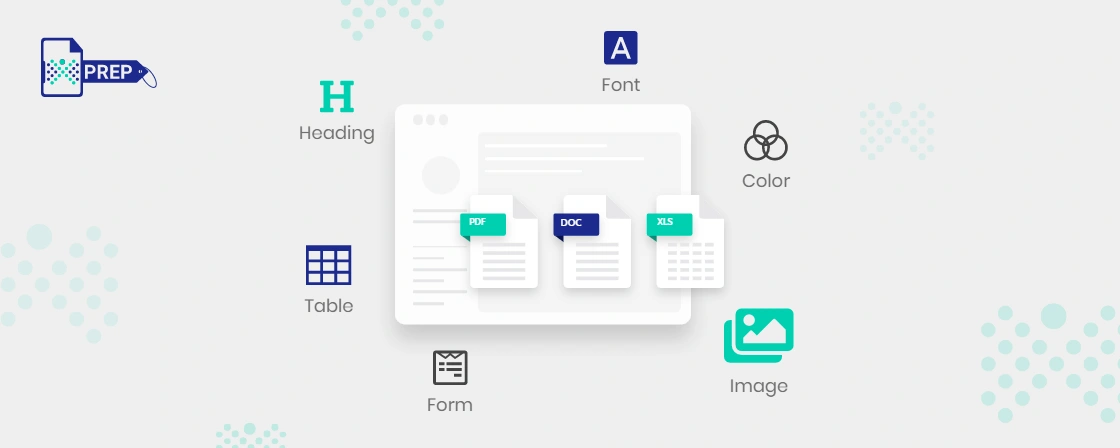Key Takeaways -
- Inaccessible websites and documents can hinder your business growth and put you at legal risk.
- Starting with a simple accessibility checklist for documents is the first step for new companies.
- Some accessibility concerns to be noted include size & type of font, multimedia alternatives, structured headings, tables, lists, and more.
- An accessibility statement is essential to show your commitment towards digital accessibility and inclusivity for your users.
What You Need to Know About Creating Accessible Documents
Font
When text is too small or too vague, it prevents users with visual disabilities from reading them— that’s why font size and type matter. Sans serif fonts are preferable for larger texts and smaller text sizes, while reserve serif fonts are better suited for headings and titles, and the use of script and decorative fonts should be limited. Users should also be able to change the text size according to their convenience: enlarge or decrease them.
Descriptive links
Instead of reading them, users of assistive technology frequently extract identifiable hyperlinks as a list. Long hyperlink addresses with numbers and symbols can be difficult to listen to when read aloud. Instead, creating hyperlinks with custom text using basic language and distinguishing them from non-linked text with an attribute other than color, like italics or underlining, can improve usability and increase interaction. The custom text should avoid non-descriptive phrases like “click here”. The ideal hyperlink text is concise, clearly identifiable, and communicates the link destination.
Semantic headings
Titles and headings are tags that establish the structure and hierarchy of content within a given page. People can use screen readers to listen to a list of all the headings and navigate directly to what they want. There is only one level 1 header, which is the title. Level 2 headings are used for sectioning content into categories. While level 3, 4, 5, and 6 headings are used to further break down each topic into smaller sub-categories.
Lists
The semantic structure of unordered or ordered lists is created by elements such as bullets, numbering, or outlining.
Color considerations
It is better to avoid using color exclusively to convey meaning or as a representation or emphasis. Creating accessible documents includes adding textures, icons, or underlined text to help people with visual or cognitive disabilities differentiate information and access content. The appropriate contrast between the text and background can help alleviate visual challenges.
Multimedia
Accessible documents provide alternatives to those needing help understanding multimedia content in documents, such as captioning and transcripts, synced with the video or as a separate file for deaf users, text versions of audio files or notifications, or a non-animated version or options for pausing an animation or other movements
Captions
Accessible documents are essential to people with hearing impairments too. Provide captions or an audio transcript if video or audio content is integrated into or connected to a document.
Tables
Basic accessibility of documents with tables consists of a simple design and column and row headers. When adding tables, keep the structure of rows and columns as simple as possible.
Navigation
Many people who are disabled navigate using only a keyboard. In a correctly structured site, navigation proceeds in a logical and orderly manner from the address bar to other content areas. This enables keyboard-only users to move through a page and a site logically. These site code labels provide indicators for navigating a page. Allowing screen readers to identify a label as a landmark lets users access any section quickly without listening to the entire page text.
Forms
Since most forms include many of the abovementioned elements, it is crucial to provide enough information so people can use them efficiently. Accessibility of documents like forms requires:
- A user should be able to navigate through the document easily.
- All form fields and controls must be labeled and indicate appropriate information or action.
- Extending the time-out feature in online forms for individuals that require more time than has been allotted.
- Using labels for fields and inputs for people who use screen readers to navigate through the form. Placeholder text inside fields usually has low contrast and is harder to read.
Accessibility statement
Once you’ve established an accessible digital environment, publishing an accessibility statement is the next step. This shows your commitment to creating an inclusive space for your users. An essential document, ensure your accessibility statement communicates your organization’s efforts towards accessibility of documents and business contact details and that it can be easily found on your website.
Conclusion
Since technology has been deeply integrated into everyday activities, when organizations fail to incorporate accessibility practices in their products, services, and work environments, they are excluding people with disabilities from enjoying equal access. While attaining complete accessibility may not be easy, following the Web Content Accessibility Guidelines 2.1, assessing problematic areas of your digital documents and continuing to make improvements is a significant way of enhancing user-friendliness, accessible documents, and creating an inclusive digital environment.

